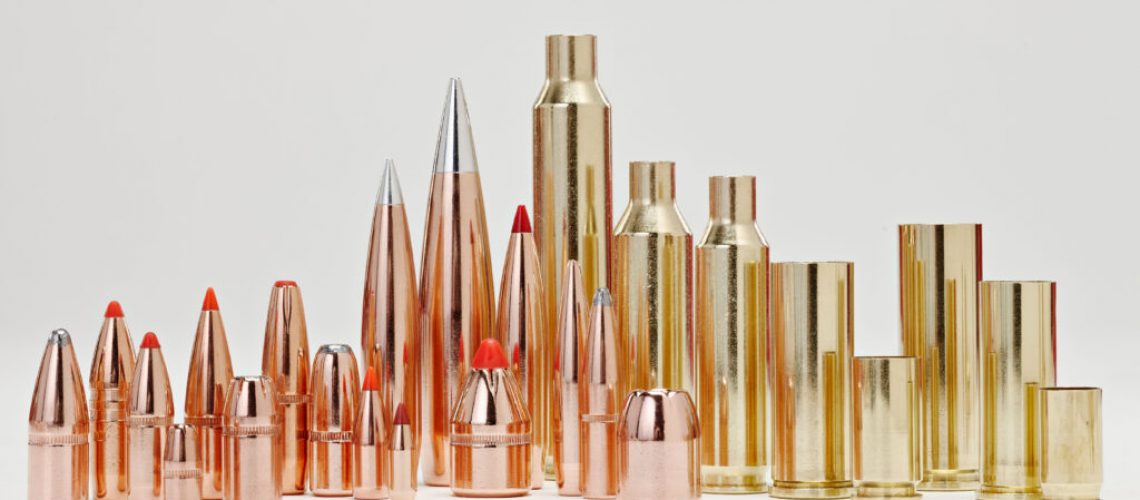Different bullets with different materials and different designs for different purposes. It’s good to know as many as possible, so you can get the best performance from your firearm efforts.
Here are just a few mainstream examples you’ll want to keep in mind.
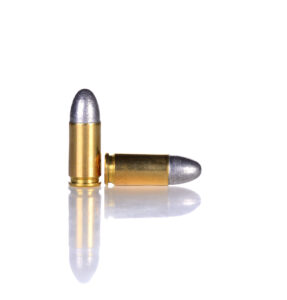 Lead Round Nose—composed entirely of lead, the LRN has no jacket. Also, as the name would indicate, the nose of the bullet is smooth and round. They’re a cheap option for the range, and will expand on impact with a solid object. That makes them a reasonable alternative for self-defense, but they don’t really perform as well as hollow point bullets for self-defense. Some shooters even cast their own solid lead bullets. Because the surface of a cast lead bullet is soft and not perfectly smooth, these bullets are common in revolvers, but less desirable in semi-automatics with complex feeding mechanisms.
Lead Round Nose—composed entirely of lead, the LRN has no jacket. Also, as the name would indicate, the nose of the bullet is smooth and round. They’re a cheap option for the range, and will expand on impact with a solid object. That makes them a reasonable alternative for self-defense, but they don’t really perform as well as hollow point bullets for self-defense. Some shooters even cast their own solid lead bullets. Because the surface of a cast lead bullet is soft and not perfectly smooth, these bullets are common in revolvers, but less desirable in semi-automatics with complex feeding mechanisms.
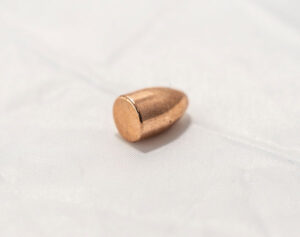 Plated Bullets—Starting with lead that’s extruded into wire then swaged into a core, these bullets are electroplated with copper, creating a solid bond that leaves no exposed lead. The copper-plated cores are then re-struck to ensure no lead exposure. They’re an inexpensive alternative to Full Metal Jack bullets for plinking or target shooting at the range.
Plated Bullets—Starting with lead that’s extruded into wire then swaged into a core, these bullets are electroplated with copper, creating a solid bond that leaves no exposed lead. The copper-plated cores are then re-struck to ensure no lead exposure. They’re an inexpensive alternative to Full Metal Jack bullets for plinking or target shooting at the range.
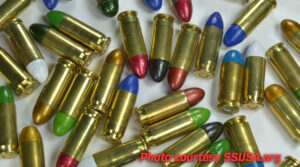
Poly-coated Bullets—polymer coats the entire bullet, creating a number of advantages of shooting or loading by hand. Because they’re coated in polymer, they don’t release as much gas from each round, which helps with indoor shooting. The polymer creates a smooth feed in magazine loaded firearms. And the polymer also reduces residue left in a firearm’s barrel. Sometimes color-coded by use.

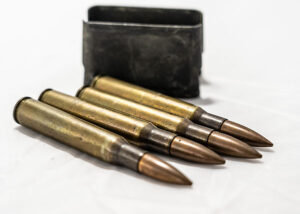 Full Metal Jacket—bullets that are encased in a shell of harder metal, typically around lead. The “jacket” can be made of metals such as cupronickel (a copper-nickel alloy), gilding metal (brass that is 95% copper), or even steel alloy. Fully jacketed bullets usually can maintain higher muzzle velocity—and don’t deposit significant amounts of metal in the barrel. Their even shape and smooth finish tends to make them accurate and feed reliably in semi-automatic and even fully-automatic weapons. The hard metal means full metal jacket bullets don’t have a tendency to expand after hitting their target, which in combat or self-defense equates many times to less physical damage.
Full Metal Jacket—bullets that are encased in a shell of harder metal, typically around lead. The “jacket” can be made of metals such as cupronickel (a copper-nickel alloy), gilding metal (brass that is 95% copper), or even steel alloy. Fully jacketed bullets usually can maintain higher muzzle velocity—and don’t deposit significant amounts of metal in the barrel. Their even shape and smooth finish tends to make them accurate and feed reliably in semi-automatic and even fully-automatic weapons. The hard metal means full metal jacket bullets don’t have a tendency to expand after hitting their target, which in combat or self-defense equates many times to less physical damage.
 Hollow Point—a controlled penetration expanding bullet. Traditionally, hollow points have been used due to their expansion causing more serious or lethal injury to a target without penetrating deeper than necessary. The inside edge of the hollow point expands when striking a target—causing a mushrooming effect that creates a greater surface area for the projectile.
Hollow Point—a controlled penetration expanding bullet. Traditionally, hollow points have been used due to their expansion causing more serious or lethal injury to a target without penetrating deeper than necessary. The inside edge of the hollow point expands when striking a target—causing a mushrooming effect that creates a greater surface area for the projectile.

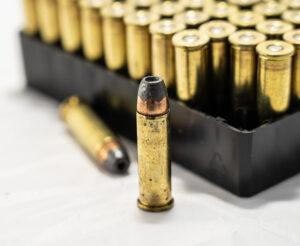 Semi-Jacketed Hollow Point—designed predominantly for self-defense, the partial jacket of the bullet creates a somewhat predictable mushrooming on impact, along with the expansion characteristic of a regular hollow point. It combines attributes of the hollow point with the additional penetration of a semi-jacketed round. It gained favor in the 70’s and 80’s with law enforcement officers using service revolvers.
Semi-Jacketed Hollow Point—designed predominantly for self-defense, the partial jacket of the bullet creates a somewhat predictable mushrooming on impact, along with the expansion characteristic of a regular hollow point. It combines attributes of the hollow point with the additional penetration of a semi-jacketed round. It gained favor in the 70’s and 80’s with law enforcement officers using service revolvers.

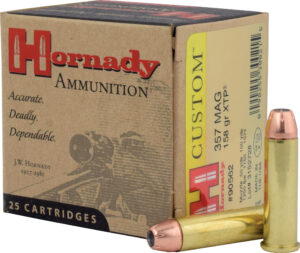 Jacketed Hollow Point—Easier feeding, and less lead residue in the barrel than a semi-jacketed hollow point. The expansion characteristics of a regular hollow point, with the additional penetration capabilities provided by the hard metal of the jacket. This particular bullet is excellent for home and self-defense as well as hunting. It comes in a wide variety of shapes and styles from a large number of manufacturers.
Jacketed Hollow Point—Easier feeding, and less lead residue in the barrel than a semi-jacketed hollow point. The expansion characteristics of a regular hollow point, with the additional penetration capabilities provided by the hard metal of the jacket. This particular bullet is excellent for home and self-defense as well as hunting. It comes in a wide variety of shapes and styles from a large number of manufacturers.

Soft Point—an open tipped bullet, with softer metal exposed at the tip, jacketed with stronger metal down the body of the projectile. Intended to create a wound greater in diameter through expansion after striking an object. Sometimes called a “spire point,” this design is popular in hunting loads for centerfire rifles.
 Armor Piercing—bullets intended to penetrate shields or devices like body armor or ballistic armor designed to deflect or stop regular bullets. Typically, armor piercing rounds are comprised of a hardened steel, tungsten, or tungsten carbide body encased with a cupronickel or copper jacket. The high-density body is intended to carry as much energy as possible into the target. While these are still made throughout the world, they are now generally prohibited from being imported to the United States as they are not intended for “sporting purposes.”
Armor Piercing—bullets intended to penetrate shields or devices like body armor or ballistic armor designed to deflect or stop regular bullets. Typically, armor piercing rounds are comprised of a hardened steel, tungsten, or tungsten carbide body encased with a cupronickel or copper jacket. The high-density body is intended to carry as much energy as possible into the target. While these are still made throughout the world, they are now generally prohibited from being imported to the United States as they are not intended for “sporting purposes.”


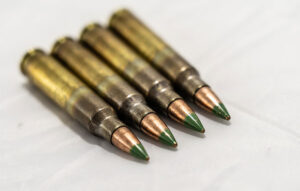 Steel Penetrator—originally known as the Belgian-made SS109 in NATO’s standardization trials, which it won. This 5.56x45mm round is now known as the M855. The signature green tip was originally used to distinguish it from older rounds, and the traditional tip color has continued to this day. A heavy lead cored round, it has often been the subject of scrutiny and attempted bans, but is currently legal for US civilians under federal law. The mild steel insert helps the round penetrate better than an FMJ without truly being an “AP” round. Because the sighting systems on many service rifles are designed for the M855, it became somewhat common in competitive use with service rifle divisions (within the civilian marksmanship program, for example).
Steel Penetrator—originally known as the Belgian-made SS109 in NATO’s standardization trials, which it won. This 5.56x45mm round is now known as the M855. The signature green tip was originally used to distinguish it from older rounds, and the traditional tip color has continued to this day. A heavy lead cored round, it has often been the subject of scrutiny and attempted bans, but is currently legal for US civilians under federal law. The mild steel insert helps the round penetrate better than an FMJ without truly being an “AP” round. Because the sighting systems on many service rifles are designed for the M855, it became somewhat common in competitive use with service rifle divisions (within the civilian marksmanship program, for example).
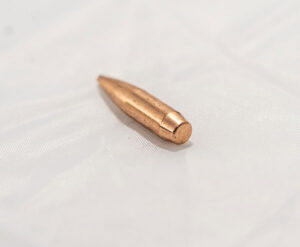 Boat Tail—the tapering of a bullet at the base, creating a visual effect similar to that of the stern of a boat. And for somewhat the same purpose—to reduce drag. The boat tail tapering on the bullet is intended to increase accuracy through improved aerodynamics over a flat base bullet, especially on higher velocity rifle rounds. A boat tail design can be combined with a variety of tip designs (round nose, soft point, hollow point, etc.)
Boat Tail—the tapering of a bullet at the base, creating a visual effect similar to that of the stern of a boat. And for somewhat the same purpose—to reduce drag. The boat tail tapering on the bullet is intended to increase accuracy through improved aerodynamics over a flat base bullet, especially on higher velocity rifle rounds. A boat tail design can be combined with a variety of tip designs (round nose, soft point, hollow point, etc.)
 Polymer-Tipped—bullets with a plastic or polymer tip that improves aerodynamic stability for hunting or long-range shooting. Other advantages are associated with the tip being forced back into the body of the bullet and aiding with expansion, as well as a more reliable feed in semi-automatic firearms. The concept is simple enough; it can fly like a Full Metal Jacket bullet, but expand like a hollow point. The ability to injection mold these polymer tips has also aided in manufacturing consistency. Made famous in the Nosler “Ballistic Tip” design, polymer-tipped bullets are now being made by many manufacturers for big-game hunting, long-range competition, varmint control, and now even personal defense ammunition.
Polymer-Tipped—bullets with a plastic or polymer tip that improves aerodynamic stability for hunting or long-range shooting. Other advantages are associated with the tip being forced back into the body of the bullet and aiding with expansion, as well as a more reliable feed in semi-automatic firearms. The concept is simple enough; it can fly like a Full Metal Jacket bullet, but expand like a hollow point. The ability to injection mold these polymer tips has also aided in manufacturing consistency. Made famous in the Nosler “Ballistic Tip” design, polymer-tipped bullets are now being made by many manufacturers for big-game hunting, long-range competition, varmint control, and now even personal defense ammunition.

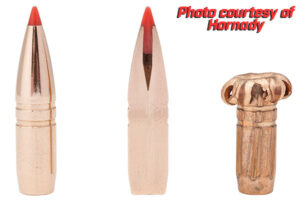 Copper Solid—This round is exactly what it sounds like: a solid piece of copper formed to a precise shape. This type of round was first known in areas that banned lead ammunition for hunting (such as California). A copper solid can have any sort of tip or base design. Modern manufacturing has taken this concept in some interesting directions, including Underwood Ammo’s “Extreme defender.” While copper is harder than lead and can be shaped very precisely, there are some disadvantages. It can be much more expensive, and special relief cuts need to be made in the body of the bullet to fully and safely engage the rifling in a barrel (further complicating the manufacturing).
Copper Solid—This round is exactly what it sounds like: a solid piece of copper formed to a precise shape. This type of round was first known in areas that banned lead ammunition for hunting (such as California). A copper solid can have any sort of tip or base design. Modern manufacturing has taken this concept in some interesting directions, including Underwood Ammo’s “Extreme defender.” While copper is harder than lead and can be shaped very precisely, there are some disadvantages. It can be much more expensive, and special relief cuts need to be made in the body of the bullet to fully and safely engage the rifling in a barrel (further complicating the manufacturing).

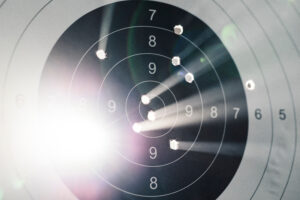 Wad Cutter—generally a flat-fronted bullet used for shooting paper targets, although it sometimes is used in short-barreled revolvers for self-defense. Frequently in use for marksmanship competitions with handguns and airguns. The flat (or nearly so, depending on the version) profile of the tip of a wadcutter bullet creates a neat, clean round hole which is desirable for scoring when shooting paper targets. The front of the wad cutter is usually the same diameter as the rest of the bullet, or close to it.
Wad Cutter—generally a flat-fronted bullet used for shooting paper targets, although it sometimes is used in short-barreled revolvers for self-defense. Frequently in use for marksmanship competitions with handguns and airguns. The flat (or nearly so, depending on the version) profile of the tip of a wadcutter bullet creates a neat, clean round hole which is desirable for scoring when shooting paper targets. The front of the wad cutter is usually the same diameter as the rest of the bullet, or close to it.
Semi Wad Cutter—flat-nosed like a wad cutter, this bullet differs from a wad cutter due to its tapered or conical nose. The smaller, conical nose with a flat front is useful when wad cutter attributes are desired, but avoids feeding issues sometimes experienced with a wad cutter in semi-automatic guns. Semi wad cutters have better aerodynamics than wad cutters, with less drag due to the conical nose. They sometimes have a concave cone leading to the flat tip, to reduce drag and weight.
These are all general categories of designs. Many manufacturers have their own proprietary versions of each style, and even hybrid combinations of multiple styles. Outside of the external shape of these designs, there are also many internal features and ways to assemble them. To note a few, Nosler’s “Partition”, Hornaday’s “Interlock”, and Federal’s “Fusion” designs are all enhanced methods of holding a metal jacket to a bullet core. This list is not all-inclusive, but hopefully it provides some understanding of the options the next time you’re looking at the ammunition counter.
Just like every firearm has particular traits, advantages, and disadvantages for your intended use, so does the ammunition. And, it’s always a good idea to keep in mind what you’re firing, as well as what you’re firing it from, to get the very best results.
